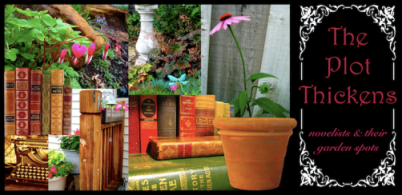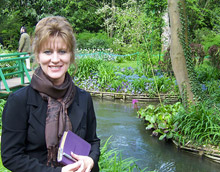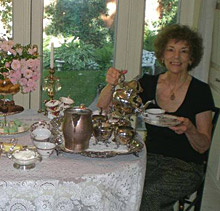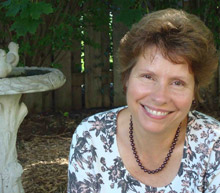
Many stories begin with a seed of an idea; and when watered by the author’s imagination, they slowly grow into messages of hope and faith.
Inspired by her love of writing and flora, author Deborah Raney began blogging about her own garden to great response. “I began hearing from other writers who had gardens,” says Deborah, “and even many who didn’t have space had made room around their homes for garden-like spaces where they could reflect, meditate on God’s Word and find inspiration for the novels they were working on.” Deborah created NovelGarden.blogspot.com, where more than 50 novelists have now shared their floral havens.
While Deborah’s own garden reflects her love of the Kansas prairie, choosing a favorite flower is hard as she claims it changes every year—“A perennial favorite is Blue Mist Spirea. It attracts hordes of bees and butterflies, and its blue color is just short of magical!” The restorative powers of a garden is a theme Deborah wove throughout Forever After (Howard/Simon & Schuster), which tells the story of the survivors of a group of firefighters killed in a homeless shelter fire. Lucas Vermontez loses his father and his ability to remain a firefighter in the tragedy. While recuperating, he is saddened to see the backyard garden his father always tended is neglected. “The state of his father’s garden represents everything Lucas has lost since his father’s death,” Deborah explains. “When Jenna, a young widow of one of the fallen firefighters, needs a place to stay, Lucas and his mother offer her their home. Jenna tries to repay their kindness by working in the garden and restoring its beauty. For her, the garden is a picture of her life coming back into bloom after an extremely difficult time.” Deborah enjoys creating unique gardens in her novels, but the garden in Forever After bore some similarities to her own. “The plants and flowers in Lucas’ garden—honeysuckle, roses, red-twig dogwood, spirea—are the same as in ours.”
Tamera Alexander
 Setting her latest historical romance, A Lasting Impression (Bethany), at Nashville’s historic Belmont Mansion enabled Tamera Alexander to describe one of the most stunning gardens of the time. “The gardens of Belmont,” explains Tamera, “consisted of three concentric circles filled with roses and other flowering shrubs and plants, as well as cast iron gazebos and animals, not to mention white marble statues and a lovely fountain in the center; and don’t forget the Bear House that housed, of course, the family’s brown bear!” As the richest woman in America, Adelicia Acklen’s Belmont gardens reflected her wealth but also her love of beauty in nature. Nature was not the only thing on display says Tamera, “The statues Adelicia purchased for the garden were incredible works of art, and the cast iron gazebos were, too. In fact, the gazebos are still standing and being used today.” Fragrant magnolias and brightly colored Japanese maples pepper her own garden, but does Tamera’s garden reflect the magnificence of Belmont’s? “Oh gracious, I wish! Ours don’t even come close, but we don’t have a gardener from Europe working for us either [as] Adelicia had! Yet the appreciation I feel for them both—the infinite creativity of the Creator that they represent—is very much the same.”
Setting her latest historical romance, A Lasting Impression (Bethany), at Nashville’s historic Belmont Mansion enabled Tamera Alexander to describe one of the most stunning gardens of the time. “The gardens of Belmont,” explains Tamera, “consisted of three concentric circles filled with roses and other flowering shrubs and plants, as well as cast iron gazebos and animals, not to mention white marble statues and a lovely fountain in the center; and don’t forget the Bear House that housed, of course, the family’s brown bear!” As the richest woman in America, Adelicia Acklen’s Belmont gardens reflected her wealth but also her love of beauty in nature. Nature was not the only thing on display says Tamera, “The statues Adelicia purchased for the garden were incredible works of art, and the cast iron gazebos were, too. In fact, the gazebos are still standing and being used today.” Fragrant magnolias and brightly colored Japanese maples pepper her own garden, but does Tamera’s garden reflect the magnificence of Belmont’s? “Oh gracious, I wish! Ours don’t even come close, but we don’t have a gardener from Europe working for us either [as] Adelicia had! Yet the appreciation I feel for them both—the infinite creativity of the Creator that they represent—is very much the same.”
Donna Fletcher Crow
 With a fantasy to live in a thatched cottage surrounded by an Old English cottage garden, Donna Fletcher Crow has tried to reflect that dream in her own garden, so far as the arid Idaho climate allows. “My garden is all perennials, and I let them reseed at will; but roses are still my favourite—David Austin English Roses, to be exact.” In Donna’s second Monastery Murders novel, A Darkly Hidden Truth, Felicity Howard, a thoroughly modern American woman, is studying theology in a seminary monastery in Yorkshire. “Many of the loveliest gardens in England are in convents and monasteries,” Donna explains. “[Because] Felicity is undertaking a discernment process to see if the life of a nun would suit her, she gets to visit several delightful gardens.” As monastery gardens are meant to be places for prayer and meditation, Donna reflects that in her book with gardens representing peace to Felicity, as this excerpt shows: “Inside the green walls of her little world spring flowers budded in peace. A peace she was far from feeling inside herself. It was so amazing, this sheltered haven only a few steps from the fighting, snarling traffic she had left behind her.” Felicity’s experience of peace is Donna’s, too. “Monastery gardens are much larger and much better maintained than mine is! Still, I find my garden to be a place of peace and prayer.”
With a fantasy to live in a thatched cottage surrounded by an Old English cottage garden, Donna Fletcher Crow has tried to reflect that dream in her own garden, so far as the arid Idaho climate allows. “My garden is all perennials, and I let them reseed at will; but roses are still my favourite—David Austin English Roses, to be exact.” In Donna’s second Monastery Murders novel, A Darkly Hidden Truth, Felicity Howard, a thoroughly modern American woman, is studying theology in a seminary monastery in Yorkshire. “Many of the loveliest gardens in England are in convents and monasteries,” Donna explains. “[Because] Felicity is undertaking a discernment process to see if the life of a nun would suit her, she gets to visit several delightful gardens.” As monastery gardens are meant to be places for prayer and meditation, Donna reflects that in her book with gardens representing peace to Felicity, as this excerpt shows: “Inside the green walls of her little world spring flowers budded in peace. A peace she was far from feeling inside herself. It was so amazing, this sheltered haven only a few steps from the fighting, snarling traffic she had left behind her.” Felicity’s experience of peace is Donna’s, too. “Monastery gardens are much larger and much better maintained than mine is! Still, I find my garden to be a place of peace and prayer.”
Maureen Lang
 Maureen Lang’s Bees in the Butterfly Garden (Tyndale) is set during the Gilded Age in New York City, where Meg Davenport is invited to redesign the city garden of the wealthy Pembertons so it will attract butterflies instead of crows. However, Meg’s fingers might be sticky, as well as green! Gardens and their inhabitants play a large part in the novel, including figuratively, as Maureen explains: “Bees, in this case, represent my would-be thieves, Meg and Ian. We all may love a garden, but we’re a bit wary of those flying stingers that are attracted to the flowers, too.” Black-Eyed Susans, petunias, daylilies, lilacs and irises litter Maureen’s own garden; but she chose something a little more exotic for her novel’s garden centrepiece. “In a book on Victorian gardens, I came across a reference to a monkey puzzle tree. I learned small ones were all the rage in Victorian gardens. They’re actually not all that pretty, but with a name like monkey puzzle, it was too great to pass up.” Maureen hopes her own garden flourishes next year: “The garden is barely holding on through our drought. I’m afraid my imaginative garden is far more lush than my real one, at least this year.”
Maureen Lang’s Bees in the Butterfly Garden (Tyndale) is set during the Gilded Age in New York City, where Meg Davenport is invited to redesign the city garden of the wealthy Pembertons so it will attract butterflies instead of crows. However, Meg’s fingers might be sticky, as well as green! Gardens and their inhabitants play a large part in the novel, including figuratively, as Maureen explains: “Bees, in this case, represent my would-be thieves, Meg and Ian. We all may love a garden, but we’re a bit wary of those flying stingers that are attracted to the flowers, too.” Black-Eyed Susans, petunias, daylilies, lilacs and irises litter Maureen’s own garden; but she chose something a little more exotic for her novel’s garden centrepiece. “In a book on Victorian gardens, I came across a reference to a monkey puzzle tree. I learned small ones were all the rage in Victorian gardens. They’re actually not all that pretty, but with a name like monkey puzzle, it was too great to pass up.” Maureen hopes her own garden flourishes next year: “The garden is barely holding on through our drought. I’m afraid my imaginative garden is far more lush than my real one, at least this year.”
Susan Meissner
 Just as her novels have many unique qualities, so does Susan Meissner’s most cherished flora! “I love every succulent and cactus there is. They are so intricately designed and have their own personalities. When they bloom, their petals are as fragile as paper and as beautiful as a painting.” Just as intricate are the stories Susan weaves in A Sound Among the Trees (Waterbrook Press). “The story is told through the points of view of a new bride named Marielle and an 83-yearold matriarch named Adelaide, as well as the historical point of view of Susannah Page.” At the heart of the novel is Holly Oak—a house and its garden—the garden symbolic of the spiritual message within the pages, as Susan explains: “A little yellow buttercup will rise up between the cracks in a ghetto’s pavement just as easily as on the tenth green at an exclusive country club. We too need to bloom where we are planted because it’s what we do with what we’ve been given that makes the difference between a content life and an unhappy one. This is what Adelaide, Marielle and even Susannah must embrace.” While Susan couldn’t populate her novel’s garden with succulents, she included her first botanical love through Marielle. “I made Marielle from Phoenix. It’s another reason she’s finding it hard to fit in at Holly Oak. She misses her cactus garden back home!”
Just as her novels have many unique qualities, so does Susan Meissner’s most cherished flora! “I love every succulent and cactus there is. They are so intricately designed and have their own personalities. When they bloom, their petals are as fragile as paper and as beautiful as a painting.” Just as intricate are the stories Susan weaves in A Sound Among the Trees (Waterbrook Press). “The story is told through the points of view of a new bride named Marielle and an 83-yearold matriarch named Adelaide, as well as the historical point of view of Susannah Page.” At the heart of the novel is Holly Oak—a house and its garden—the garden symbolic of the spiritual message within the pages, as Susan explains: “A little yellow buttercup will rise up between the cracks in a ghetto’s pavement just as easily as on the tenth green at an exclusive country club. We too need to bloom where we are planted because it’s what we do with what we’ve been given that makes the difference between a content life and an unhappy one. This is what Adelaide, Marielle and even Susannah must embrace.” While Susan couldn’t populate her novel’s garden with succulents, she included her first botanical love through Marielle. “I made Marielle from Phoenix. It’s another reason she’s finding it hard to fit in at Holly Oak. She misses her cactus garden back home!”
This article originally appeared in the September/October 2012 issue of FamilyFiction digital magazine. Subscribe for free today!

